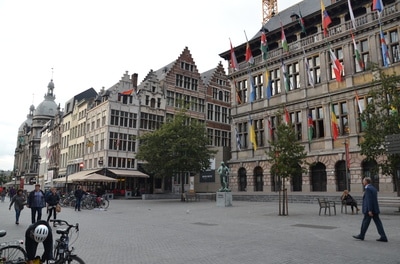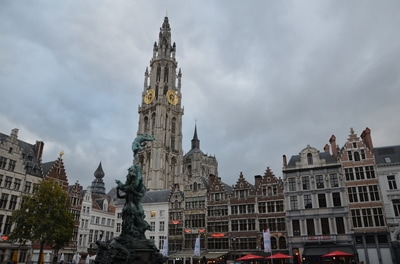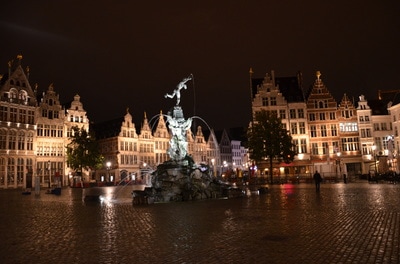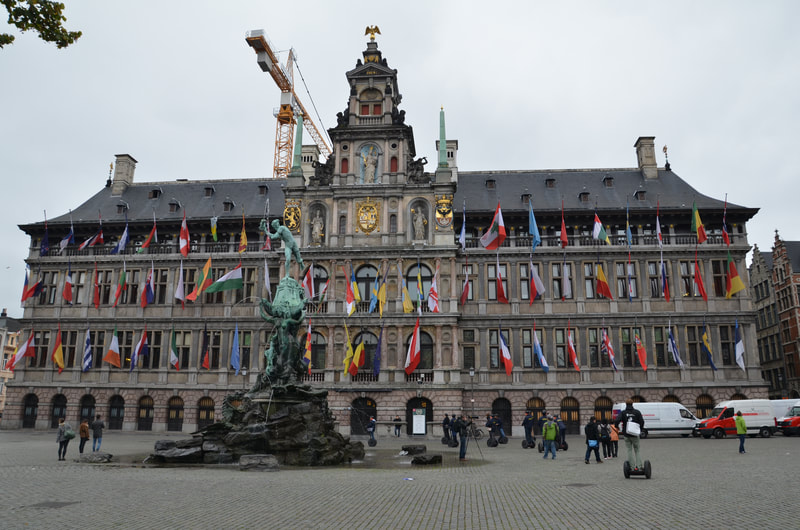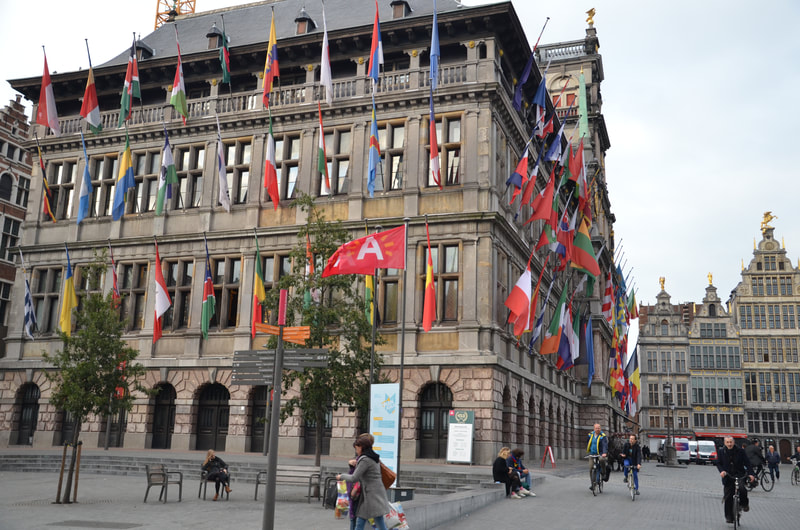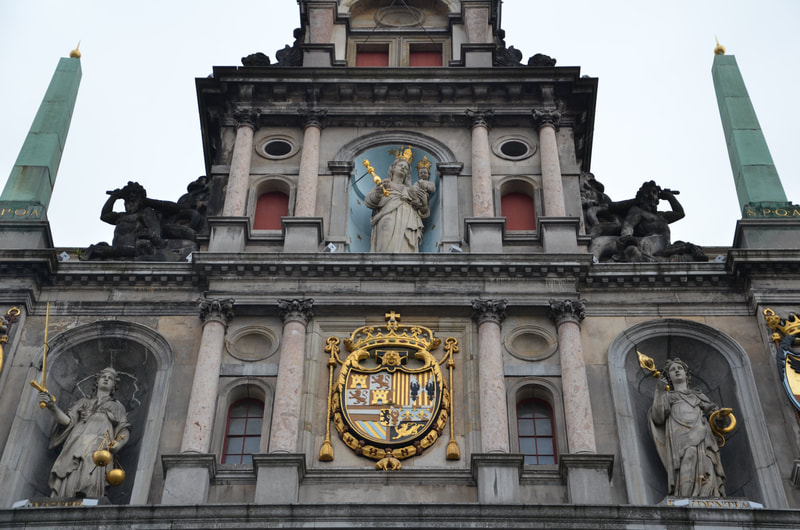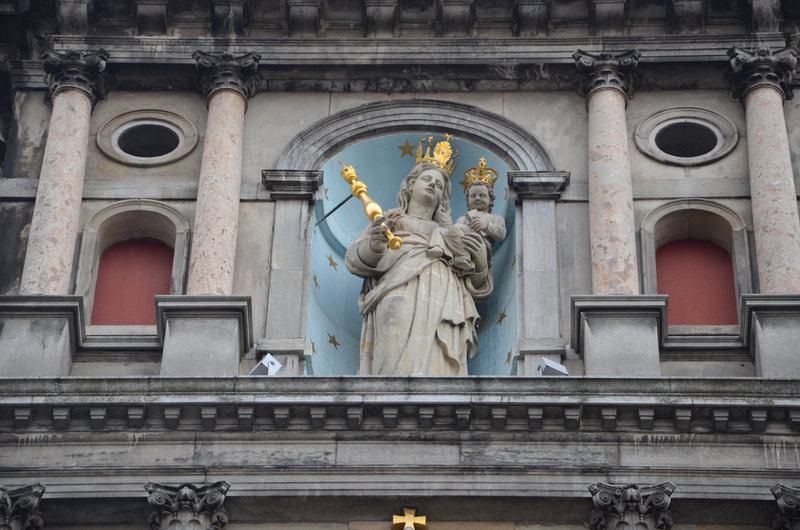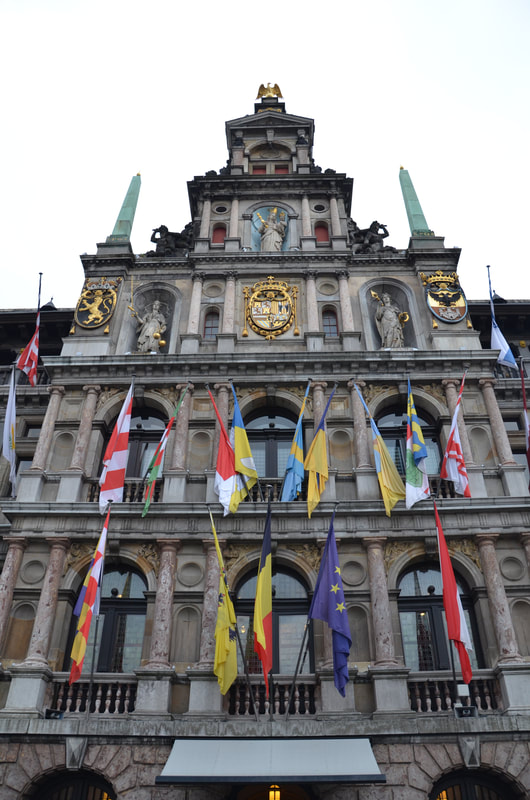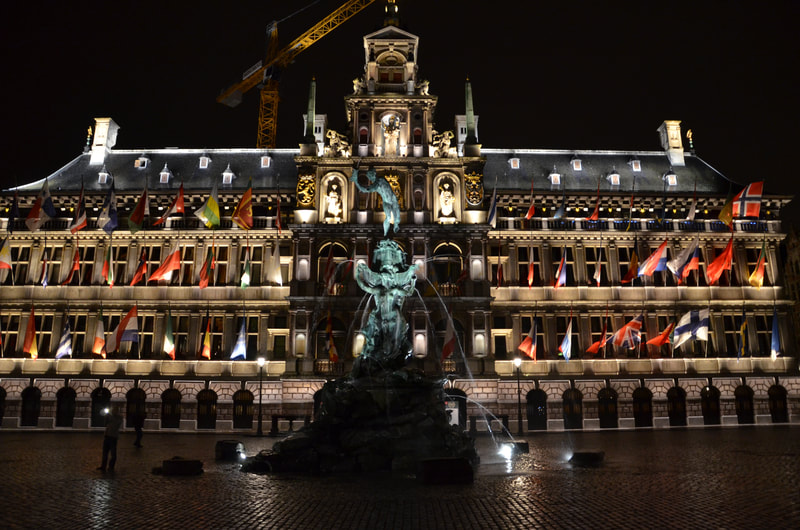Antwerp's main square
The Grote Markt is the heart of Antwerp. All paths intertwine in the centre of the old town. In 1220 the Duke of Brabant (1165-1235) donated the land on which this magnificent square stands to the city. In the Middle Ages, numerous fairs and markets of Brabant were organised here. On the main market square, English merchants did business with merchants arriving from Italy, Spain and the northern German Hanseatic cities. The beauty and splendor of the surrounding tenement houses, as well as the monumental cathedral, testify to the prosperity and wealth of medieval Antwerp, which in the 15th century surpassed Bruges to become the most important city in the Netherlands.
Silvius Brabo Fountain
Fontanna stoi w centrum rynku. Jej cokół stanowią, wydawać by się mogło bezładnie ułożone kamienie, na których szczycie stoi wykonany z brązu posąg Silviusa Brabo. Jest on tutaj przedstawiony w momencie, kiedy wrzuca do rzeki Skaldy rękę odrąbaną olbrzymowi Antigonusowi. Jak głosi miejska legenda, olbrzym Antigonus pobierał cło od wszystkich przepływających w pobliżu miasta okrętów. Każdemu, kto odmawiał zapłaty obcinał ręce. Szybko stał się postrachem marynarzy. Sytuacja ta miała miejsce do czasu kiedy to dzielny Silvius Brabo wyzwał olbrzyma na pojedynek. Pokonanemu Antigonusowi obciął rękę, którą następnie wrzucił do Skaldy. Według legendy zdarzenie to przyczyniło się do powstania nazwy miasta, która dosłownie znaczy rzucona ręka.
16th century guild houses
Po północnej stronie rynku stoją pięknie odrestaurowane szesnastowieczne kamienice, tzw. domy cechowe. Ozdobione płaskorzeźbami odpowiadającymi przeznaczeniu domu i zwieńczone pozłacanymi posągami. Pod numerem 7 znajduje się Het Pand van Spanje (Pod Świętym Jerzym), czyli Dom Kuszników. To najwyższa i najbardziej okazała kamienica w tym miejscu. Jej szczyt zdobi figura świętego Jerzego na koniu, walczącego ze smokiem. Kamienica posiada wielkie prostokątne okna, których obramowania ozdobiono charakterystycznymi rzeźbami.
Dom stojący obok De Gulden Mouw (Pod Złotym Rękawem) należał do cechu bednarzy. Świadczą o tym dekoracje w kształcie beczułek. Na szczycie budynku znajduje się rzeźba Świętego Mateusza. Część domów to autentyczne, odrestaurowane XVI, XVII- wieczne budynki, reszta to XIX-wieczne rekonstrukcje, wykonane na podstawie obrazów i starych dokumentów.
Ratusz stojący po przeciwnej stronie rynku to prawdziwe dzieło sztuki, jeden z najwspanialszych przykładów renesansu w Niderlandach. Jego budowę rozpoczęto w 1561 roku, według nowatorskiego projektu Cornelisa II Florisa de Vriendta. Po czterech latach ratusz był gotowy. Fasadę tego pięknego budynku zdobią liczne posągi i herby. W 1576 roku, podczas wojny hiszpańskiej, ratusz został podpalony przez zbuntowanych hiszpańskich żołnierzy. Ocalały wówczas tylko zewnętrzne mury. Trzy lata później, w 1579 roku ratusz odbudowano. Fasada budynku ozdobiona jest wysmukłymi pilastrami, a w ryzalicie środkowym kolumnami jońskimi i doryckimi.
W drugiej i trzeciej kondygnacji ryzalitu znajdują się okazałe, półkoliście zamknięte portes-fenetres, które zastępują prostokątne okna. Na czwartej kondygnacji widać wysokie cokoły stanowiące podstawy obelisków z herbami Brabancji, Królestwa Belgii i miasta. W niszach pomiędzy herbami umieszczono rzeźby będące alegorią Sprawiedliwości i Mądrości. W niszy na wyższej kondygnacji znajduje się posąg Matki Boskiej z Dzieciątkiem. Rzeźbę wykonał, w 1587 roku, Filip de Vos. Na szczycie budynku znajduje się trójkątny fronton z datą 1564. Całość wieńczy rzeźba orła, którego głowa zwrócona jest w kierunku Akwizgranu.
The interior was renovated in the 19th century to meet modern requirements. The courtyard was roofed and a staircase was added. The walls of the interior are decorated with numerous portraits of painters, mayors, and monarchs. It is worth seeing the Leys Hall, named after Baron Hendrik Leys. In 1860 he painted the frescoes that decorate it. Equally interesting is the Wedding Hall, which contains a fireplace from the original town hall, decorated with two alabaster caryatids (an architectural support in the form of a female figure, supporting an architectural element of the building on its head) made by Floris himself. In 1999 the town hall was added to the UNESCO World Heritage List.
Cathedral of the Virgin Mary (Onze Lieve Vrouwe Cathedral)
to największa tego typu gotycka budowla w Belgii (118 m długości, 53,50 m szerokości, 40 m wysokości). Powstawała w latach 1352-1521 i nigdy nie została ukończona według pierwotnych założeń, czego dowodem jest jedna z niższych wież. Ten jeden z najpiękniejszych gotyckich kościołów w Belgii w większej części został zbudowany przez Jana i Piotra Appelmansów, w pierwszej połowie XVI wieku. Jego 125-metrowa wieża góruje nad krajobrazem Antwerpii. Szczególnie imponujące jest wnętrze kościoła – 7 naw wspartych na 125 kolumnach, 128 okien (55 witrażowych), wieża północna i wieża południowa, ośmioboczna latarnia na przecięciu nawy i transeptów, chór, ambit i 11 kaplic – te liczby dają wyobrażenie o tym jak potężna jest to budowla. W świątyni zgromadzono niezwykłe dzieła sztuki sakralnej, wszystkie one pozostają jednak w cieniu doskonałych obrazów Rubensa.
